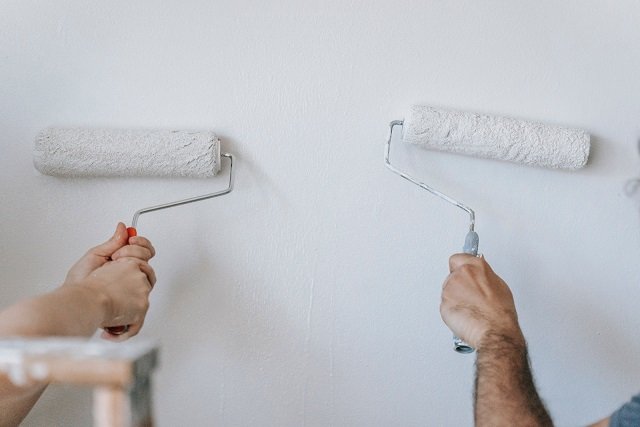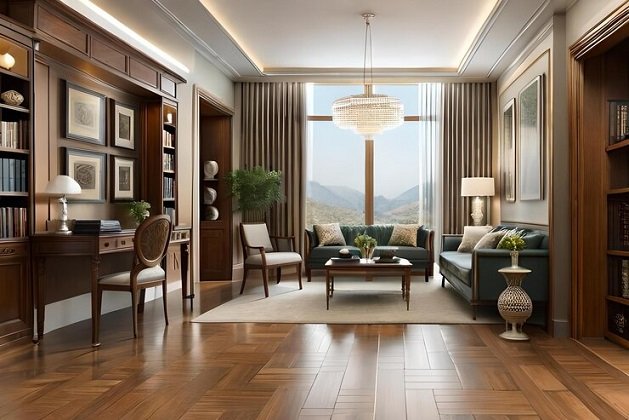Introduction
Are you feeling overwhelmed by all the paint colors available for your home? Many of us grapple with making decisions when picking just the right hue to accent pieces that express our creativity and personal style. Whether you’re a first-time homeowner, renovator, or decorator, choosing the perfect paint color can be an intimidating task. Don’t worry– this blog post is here to help! We’ll give you insider tips on selecting stylish paints to make your home look its best. Keep reading for easy and effective color inspiration strategies to help you achieve perfect results every time!
Choosing Interior Paint Colors
Choosing the perfect paint colors for your home can significantly impact the atmosphere and aesthetics. Here are seven tips to help you make the right choices:
- Consider the Purpose of the Room:
When choosing paint colors for your home, it is crucial to consider the purpose of each room. Understanding a space’s function and intended use will help guide your color selection, as different shades can evoke specific emotions and create distinct atmospheres. For instance, in a bedroom meant for relaxation and restorative sleep, soothing blues or soft neutrals are often recommended to promote tranquility. On the other hand, vibrant yellows or energetic greens might be more fitting choices for a home office or study area, as they can boost creativity and productivity. When selecting paint colors for common areas like living rooms or kitchens, it is advisable to consider both personal preference and the desired ambience – warm tones such as earthy browns or rich oranges can evoke comfort and coziness. At the same time, cooler hues like greys contribute to a modern and sleek feel. By considering the purpose of each room when choosing paint colors, you can create an inviting environment that perfectly suits your needs. - Understand Color Psychology:
Understanding color psychology is essential when it comes to choosing paint colors for your home, as colors can have a significant impact on our emotions and mood. Certain colors elicit specific feelings; for example, blue is often associated with calmness and tranquillity, while yellow is believed to promote optimism and happiness. It is crucial to consider each room’s purpose before deciding. For instance, warm tones like red or orange might be suitable for social spaces as they encourage energy and conversation. In contrast, cooler hues such as green or purple can create a more serene atmosphere in bedrooms or study areas. Additionally, considering the lighting conditions of each room is vital as natural light can enhance or alter how colors appear. By delving into the realm of color psychology and thoughtfully selecting paint colors that align with desired emotions and functionalities, homeowners can create harmonious living spaces that cater to their needs and preferences. - Pay Attention to Lighting:
When choosing the perfect paint colors for your home, attention to lighting is essential. How a color appears can vary significantly depending on the type and amount of light in a space. Natural daylight casts a different hue than artificial lighting, such as incandescent or fluorescent bulbs. It is also important to consider the direction and intensity of light sources. North-facing rooms receive cool, blue-toned light, while south-facing areas are bathed in warm, yellowish light. To ensure accurate color representation, it is advisable to test paint swatches at different times of the day and under the various types of lighting in your home. How each shade reacts will help you make informed choices that complement your space’s unique lighting conditions and achieve the desired ambiance in every room. - Coordinate with Existing Elements:
When choosing the perfect paint colors for your home, one important aspect to consider is coordinating with existing elements. This requires carefully assessing your space’s current furniture, flooring, and architectural features. By selecting paint colors that harmonize well with these elements, you can create a cohesive and visually appealing environment. Start by identifying the dominant hues in your furnishings and use them as a guide. For instance, if you have a bold blue couch, consider selecting shades of blue or complementary colors such as cool grays or earthy neutrals for the walls. - Additionally, please consider the natural lighting in each room when making your color choices, as it can greatly influence how different hues appear. Remember that while vibrant accent walls can add interest to a space, they should be chosen carefully to avoid clashing with other elements. Paying attention to coordination will help ensure that your chosen paint colors enhance the overall aesthetic of your home.
- Sample the Colors:
When choosing the perfect paint colors for your home, the task may seem overwhelming. However, you can navigate the process seamlessly with expert tips and guidance. One valuable technique is sampling the colors before making a decision. By purchasing small paint samples and applying them to different walls in your home, you can observe how they interact with natural light at different times. Additionally, it is crucial to consider the undertones of each color and ensure they complement other elements in your space, such as furniture or flooring. Professional advice suggests experimenting with complementary or analogous color schemes to achieve a harmonious ambiance. Furthermore, considering the psychological impact of colors on mood and emotions can help create specific atmospheres within your rooms. By following these proven techniques and considering professional advice, you can confidently select paint colors that will transform your space into a personalized haven filled with beauty and serenity. - Think About Flow:
When it comes to selecting paint colors for your home, considering the flow and overall aesthetic of your space is crucial. “Think About Flow: Tips for Choosing the Perfect Paint Colors for Your Home” provides valuable insights on achieving a harmonious color scheme that complements every room. This article guides readers toward making informed decisions by considering factors such as lighting, room size, and furniture style. It emphasizes the importance of creating a cohesive palette throughout the house while allowing flexibility for individual room personalities. The author also suggests using color psychology to influence mood and ambience, enhancing each area’s functionality. With its professional tone and well-researched recommendations, this article is an excellent resource for homeowners seeking expert advice in their quest for the perfect paint colors. - Consider Your Personal Preferences:
When choosing the perfect paint colors for your home, it is crucial to consider your personal preferences. The color scheme of your home plays a significant role in creating a harmonious and inviting atmosphere. One important tip is to consider your style and the overall aesthetic you want to achieve. If you prefer a calming ambience, selecting neutral tones such as beige or light grey would be ideal, while vibrant shades like teal or mustard can add energy and personality. Considering the size of each room is also essential; lighter colors can make smaller spaces appear larger, while darker hues can create a cozy feel in larger rooms. Additionally, remember to test different paint samples on the walls before making a final decision; natural light and artificial lighting can greatly affect how colors look in different settings. By carefully considering your personal preferences, you can choose paint colors that perfectly reflect your taste and create a welcoming environment in your home.
Bonus Tip: If you’re still uncertain about choosing the right wall colors, consider consulting with a professional interior designer or color consultant. They can provide expert guidance tailored to your preferences and the specific characteristics of different rooms in your home.
Remember that selecting the perfect paint colors is a personal journey, and it’s okay to take your time to find the combinations that suit you best. The best and safest to pick paint colors this way is to always consult with thee professionals like Brisbane painters and decorators for a more professional finish. Happy painting!

FAQs
What are some popular paint colors for home interiors?
When choosing paint colors for home interiors, several popular options can transform the look and feel of any space. One of the most timeless choices is a more neutral color palette, including shades like white, beige, and gray. These colors provide a versatile backdrop that can complement any décor style and create an airy and peaceful atmosphere. For those looking to add a touch of sophistication, deeper tones such wall colors such as navy blue or rich emerald green have gained popularity in recent years as they lend an elegant and dramatic vibe to any room. Additionally, soft pastel hues like blush pink or mint green are trending among homeowners who desire a more tranquil and relaxing ambience. Ultimately, the choice of paint color should be based on personal taste and how it complements existing furniture and decor elements within the home.
How do I choose the right paint color for a small room?
When choosing the right paint color for a small room, it’s important to consider a few key factors. First and foremost, opt for lighter shades favorite colors, as they tend to create an illusion of a larger space. Pale pastels and neutral tones like light gray or beige can expand the room’s appearance. Additionally, pay attention to natural lighting in the space. If the room has limited access to natural light, avoid dark colors that may make the space feel even smaller and gloomier.
Furthermore, be mindful of the purpose of the room and its desired atmosphere. Consider cool colors such as blues or greens for a calming effect or a lighter shade of warm hues like yellows or oranges to create a cozy ambience. Lastly, before committing to a particular shade ceiling color, test samples on different walls to see how they interact with natural and artificial lighting throughout the day. This will help you make an informed decision about which color complements your small space best.
What are some tips for coordinating paint colors between rooms?
A few tips can help create a visually cohesive and harmonious space when coordinating paint colours between rooms. First, consider the overall flow and layout of dining rooms in your home. Opt for a consistent wall color, palette or theme that complements the style and architecture of your house. This will ensure a seamless transition from one room to another. Next, choose a main colour that acts as an anchor throughout the different spaces while allowing for variations in undertones or intensity. Experiment with different shades within the same color family to add depth and interest without overwhelming the senses.
Additionally, please consider the natural light in each room as it can affect how colors appear. Test paint samples on walls to see how they look under different lighting conditions before making a final choice. Lastly, consider using accent colors or small pops of contrasting hues to tie cohesive look of the rooms together while adding visual appeal and personality. By following these tips, you’ll be able to achieve a coordinated and inviting home décor effortlessly.
Conclusion
Choosing the perfect colour scheme and paint colors for your home is a challenging feat. With endless options and considerations to consider, it may initially seem overwhelming. However, by following the tips outlined in this post, you should be confident knowing that you have chosen the right color wheel and paint colors for your home to bring out each room’s beauty. Take some time to experiment with colors and test areas until you find a combination or single color that compliments the space just right. Don’t be afraid to ask for help if you are still struggling because extra opinion can be instrumental when making decisions! This little bit of effort will go a long way in giving your living space an inviting ambience no matter which color scheme or shades you decide to go with.
Autobiography
Jim Pulman has extensive knowledge and experience in Home Building, Construction, and Design. He writes articles in his free time and partners with content creators to share his expertise with the online community

















